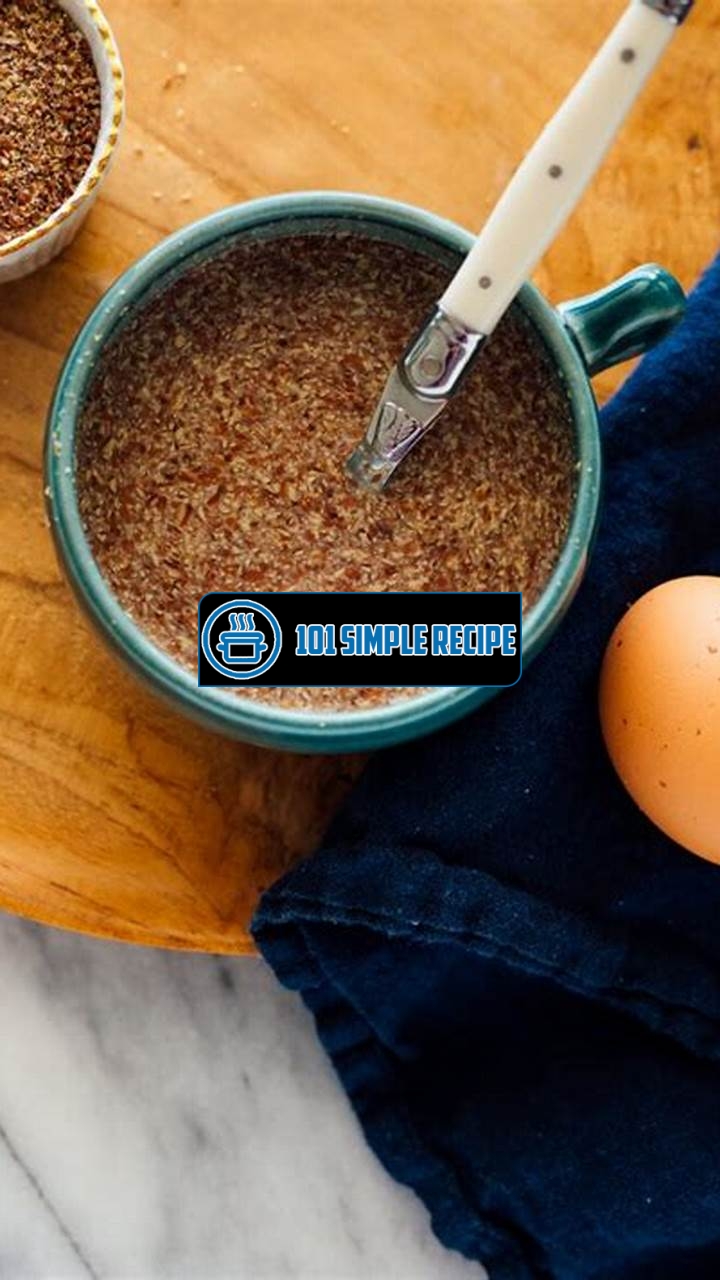If you’re searching for an easy and healthy alternative to traditional egg whites, look no further. In this article, we will guide you through the steps of making a flax egg white, a versatile and plant-based substitute that can be used in a variety of recipes. Whether you’re following a vegan diet, have an egg allergy, or simply want to experiment with new ingredients, flax egg whites are a fantastic option. ✨ So, let’s dive in and learn how to make this delightful alternative that will add a nutritious twist to your culinary creations.

Understanding Flaxseed
Flaxseed, also known as linseed, is a versatile ingredient that has gained popularity in recent years, particularly in plant-based diets. This small, shiny seed comes from the flax plant, which has been cultivated for thousands of years for its fiber and oil.
Origins: Flaxseed has a rich history dating back to ancient civilizations such as Ancient Egypt and Mesopotamia, where it was highly valued for its nutritional and medicinal properties. Today, flax is grown primarily in Canada, Russia, and China.
Benefits: Flaxseed is renowned for its nutritional benefits. It is a rich source of omega-3 fatty acids, fiber, and lignans, which are phytoestrogens that act as antioxidants. These compounds have been linked to numerous health benefits, making flaxseed a valuable addition to any diet.
The Nutritional Profile of Flaxseed
Flaxseed is packed with essential nutrients that provide a range of health benefits. Here are some key nutritional facts about flaxseed:
Note: Flaxseed is high in calories, so it is important to incorporate it into your diet in moderation.
- Omega-3 Fatty Acids: Flaxseed is one of the richest plant-based sources of omega-3 fatty acids, particularly alpha-linolenic acid (ALA). These essential fatty acids are crucial for brain health, reducing inflammation, and supporting heart health.
- Fiber: Flaxseed is an excellent source of dietary fiber. Just one tablespoon of ground flaxseed contains approximately 2 grams of fiber, which can help improve digestion, regulate blood sugar levels, and promote a healthy weight.
- Lignans: Flaxseed is the most abundant dietary source of lignans, which are antioxidants that have been associated with a reduced risk of certain cancers, such as breast, prostate, and colon cancer. Lignans also have estrogen-like properties, which may help alleviate symptoms of menopause.
- Protein: Flaxseed is a good source of plant-based protein, making it an ideal choice for vegans and vegetarians. It contains all the essential amino acids needed for muscle growth and repair.
The Health Benefits of Flaxseed
The consumption of flaxseed has been linked to various health benefits:
- Heart Health: The omega-3 fatty acids found in flaxseed help lower cholesterol levels, reduce blood pressure, and decrease the risk of cardiovascular diseases.
- Improved Digestion: The high fiber content of flaxseed aids digestion and helps prevent constipation.
- Weight Management: The combination of fiber and protein in flaxseed can promote feelings of fullness, leading to reduced calorie intake and aiding weight management.
- Reduced Inflammation: Flaxseed’s omega-3 fatty acids have anti-inflammatory properties, which can help alleviate symptoms of inflammatory conditions such as arthritis.
- Hormonal Balance: The lignans in flaxseed may help regulate hormone levels and reduce the risk of hormonal imbalances.
Using Flaxseed as an Egg Substitute
One of the most popular uses of flaxseed is as an egg substitute in baking and cooking. This is especially useful for individuals following a vegan or vegetarian lifestyle or those with egg allergies.
How to make a flax egg white:
- Mix 1 tablespoon of ground flaxseed with 3 tablespoons of water in a small bowl.
- Let the mixture sit for 5-10 minutes until it thickens and becomes gel-like.
- Use the flax egg white as a replacement for one egg in your recipe.
Flaxseed acts as a binding agent, similar to eggs, and helps create moist and tender baked goods. It works well in recipes that call for eggs, such as muffins, cookies, and pancakes.
Important: Remember to adjust the other ingredients in your recipe accordingly, as the use of flaxseed may affect the texture and flavor of the final product.
In conclusion, flaxseed is a versatile ingredient that offers numerous health benefits. Whether you are looking to boost your intake of omega-3 fatty acids, increase dietary fiber, or replace eggs in your recipes, flaxseed is a nutritious choice for any plant-based diet.
If you’re looking for a refreshing beverage to enjoy with your flax egg whites, you can try making a pink drink using fresh fruits and flax egg whites. This recipe on 101 Simple Recipe provides a simple and delicious way to enjoy your flax egg whites.
The Science Behind Flaxseed Eggs
When it comes to replacing eggs in recipes, flaxseed has become a popular choice among many people. But have you ever wondered about the science behind flaxseed eggs? Let’s explore the chemical process that occurs when flaxseed is used as a binding agent in recipes.
The Role of Flaxseed in Replacing Eggs
Flaxseed, derived from the flax plant, is rich in a type of soluble fiber known as mucilage. This fiber is what gives flaxseed its unique binding properties, making it an excellent substitute for eggs in various recipes. When combined with water, the mucilage in flaxseed forms a gel-like substance, providing the necessary structure and moisture in baked goods.
The gel-like texture of flaxseed eggs is what helps bind the ingredients together, similar to how eggs work in traditional recipes. Whether you’re vegan, have an egg allergy, or simply prefer a plant-based alternative, flaxseed eggs can effectively replace eggs in many recipes.
How Flaxseed Eggs Form a Gel
To create a flaxseed egg, you’ll need to mix ground flaxseed with water in a specific ratio. The usual ratio is 1 tablespoon of ground flaxseed mixed with 3 tablespoons of water. After mixing the two ingredients together, you’ll need to let the mixture sit for a few minutes. This allows the flaxseed to absorb the water and form a gel-like consistency.
As the flaxseed absorbs the water, the soluble fiber in it begins to expand and form a gel. This gelatinous texture is what gives flaxseed eggs their binding properties. It’s important to note that the longer you let the mixture sit, the thicker the gel will become. Therefore, you might need to adjust the amount of liquid in your recipe accordingly if you prefer a thicker or thinner consistency.
The Binding Power of Flaxseed Eggs
Flaxseed eggs possess excellent binding power, which makes them suitable for a wide range of recipes. Whether you’re making cookies, muffins, pancakes, or even veggie burgers, flaxseed eggs can effectively hold the ingredients together.
When flaxseed eggs are used in baking, they help create structure and stability in the final product. The gel-like texture formed by flaxseed eggs acts as a glue, binding the other ingredients together. This results in a moist and tender texture, similar to that achieved with traditional eggs.
Moreover, flaxseed eggs also contribute to the nutritional value of your recipe. Flaxseed is a rich source of omega-3 fatty acids, fiber, and protein, all of which offer various health benefits. By using flaxseed eggs instead of traditional eggs, you can enhance the nutritional profile of your baked goods.
To sum up, the science behind flaxseed eggs lies in the binding power of flaxseed’s soluble fiber. The gel-like consistency formed by flaxseed and water creates a structure that holds the ingredients together, making it an ideal substitute for eggs. So next time you’re looking to replace eggs in your recipes, consider giving flaxseed eggs a try!
If you’re looking for a unique twist on the traditional flax egg whites, you might want to try making peanut butter cups using flax egg whites instead. This recipe on 101 Simple Recipe shows you how to make these delicious treats.
Preparing Flaxseed Eggs
Learn the step-by-step process of creating flaxseed eggs for your favorite recipes.
Choosing the Right Flaxseed
When making flaxseed eggs, it is crucial to choose the right flaxseed to ensure optimal results. Look for organic flaxseed that is fresh and has a pleasant aroma. High-quality flaxseed can be identified by its glossy appearance and should be free from any signs of moisture or mold. It is best to purchase whole flaxseed and grind it at home, as pre-ground flaxseed may have lost some of its nutrients over time.
Note: Choosing the right flaxseed is essential to achieve the desired texture and consistency in your recipes.
Grinding Flaxseed for Optimal Results
To get the most out of your flaxseed eggs, it is recommended to grind them before using. Grinding flaxseed helps break down its hard outer shell, allowing your body to absorb the nutrients more effectively. You can use a coffee grinder, food processor, or blender to grind the flaxseed into a fine powder.
Note: For optimal results, grind the flaxseed just before you need it. This will ensure freshness and maximum nutritional value.
Mixing Flaxseed and Water Ratios
The ratio of flaxseed to water is crucial in creating the perfect flaxseed egg substitute. For each flaxseed egg, combine 1 tablespoon of ground flaxseed with 3 tablespoons of water. Stir the mixture well and let it sit for about 5-10 minutes until it thickens and becomes gel-like. This gel consistency is what makes flaxseed eggs an excellent binder in various recipes.
Note: It is important to use the correct ratio of flaxseed to water to achieve the desired results. Adjusting the ratio may affect the texture and binding properties of your flaxseed egg substitute.
Summary: The process of making flaxseed eggs involves selecting the right flaxseed, grinding it for optimal results, and mixing with the appropriate water ratio. By following these steps, you can create a nutritious and vegan-friendly egg substitute that can be used in a wide range of recipes.
Using Flaxseed Eggs in Baking
Discover the techniques for incorporating flaxseed eggs into your baked goods for delicious results.
Flaxseed Eggs in Cakes and Muffins
When it comes to baking cakes and muffins, using flaxseed eggs as a substitute for traditional eggs can be a game-changer. Flaxseed eggs are an excellent vegan and allergy-friendly alternative that adds moisture and binding properties to your baked goods.
To make flaxseed eggs, you simply need ground flaxseeds and water. For each flaxseed egg, mix one tablespoon of ground flaxseeds with three tablespoons of water. Let the mixture sit for about 5 minutes to thicken and develop an egg-like consistency.
Tip: You can use ground chia seeds in place of flaxseeds if you prefer.
In cakes and muffins, flaxseed eggs help create a soft and tender texture. They also help to hold the structure of the batter, resulting in a light and fluffy final product. The nutty flavor of the flaxseeds adds a subtle depth to the overall taste of your baked treats.
Remember: For every traditional egg in your recipe, substitute with one flaxseed egg.
Flaxseed Eggs in Cookies and Brownies
When it comes to making cookies and brownies, flaxseed eggs work wonders in creating a chewy and moist texture. The binding properties of flaxseed eggs help hold the dough together, resulting in perfectly shaped cookies and brownies.
To make flaxseed eggs, combine one tablespoon of ground flaxseeds with three tablespoons of water. Allow the mixture to sit for a few minutes until it thickens and takes on an egg-like consistency.
Pro-tip: For a richer flavor, toast the ground flaxseeds before mixing them with water.
Flaxseed eggs add a nutty flavor to your cookies and brownies, enhancing the overall taste. They also contribute to the moistness of the final product. Plus, using flaxseed eggs as a vegan alternative allows you to enjoy your favorite baked goods without the need for animal products.
Remember: Replace each traditional egg in your recipe with one flaxseed egg.
Flaxseed Eggs in Bread and Pancakes
Whether you are making bread or pancakes, incorporating flaxseed eggs in your recipes can result in outstanding texture and flavor. Flaxseed eggs act as a binder while also adding moisture and a subtle nutty taste to the final product.
To make flaxseed eggs, mix one tablespoon of ground flaxseeds with three tablespoons of water. Allow the mixture to rest for about 5 minutes until it thickens and resembles the consistency of a traditional egg.
Tip: For extra fluffiness in your pancakes, separate the flaxseed eggs into yolks and whites. Incorporate the yolks into the batter and whip the egg whites separately until fluffy. Gently fold the egg whites into the batter before cooking.
In bread, the flaxseed eggs help to bind the ingredients together and create a hearty and moist loaf. In pancakes, they add structure and aid in achieving a fluffy and light texture.
Remember: Substitute each regular egg in your bread or pancake recipe with one flaxseed egg.
By mastering the use of flaxseed eggs in baking, you can easily adapt your favorite recipes to be vegan or allergy-friendly, without sacrificing taste or texture. Give it a try and enjoy the delicious results!
To learn more about making flax egg whites, you can check out this kaiser roll recipe on 101 Simple Recipe. It includes detailed instructions on how to make the perfect flax egg whites.
Flavor Variations and Substitutions
When it comes to making flax egg whites, there are endless possibilities to explore in terms of flavor variations and substitutions. By adding different ingredients and seasonings, you can enhance your flaxseed eggs and create diverse culinary creations that cater to your taste preferences. Let’s dive into some exciting options:
Adding Sweetness with Vanilla and Cinnamon
If you have a sweet tooth, you can add a delightful touch of sweetness to your flaxseed eggs by incorporating vanilla extract and cinnamon. ✨ The aromatic vanilla extract adds a warm and comforting flavor, while the fragrant cinnamon adds a subtle kick. These flavors work particularly well in baked goods such as pancakes, muffins, and cookies.
To infuse your flaxseed eggs with sweetness, simply whisk in a teaspoon of vanilla extract and half a teaspoon of ground cinnamon into the flax egg white mixture. The result will be a flavorful and aromatic base that will elevate your sweet treats to a whole new level of deliciousness.
Savory Flaxseed Egg Seasonings
If you prefer savory dishes, you can experiment with various seasonings to add a burst of flavor to your flaxseed eggs. By incorporating herbs and spices, you can create an array of savory options that are perfect for breakfast, lunch, or dinner. Here are some suggestions to get you started:
- Garlic and Herb: Infuse your flaxseed eggs with a punch of garlic and a medley of dried herbs like oregano, thyme, and parsley. This savory combination can be used as a base for omelets, frittatas, or scrambled eggs.
- Spicy Southwest: If you crave some heat, add a teaspoon of chili powder, a pinch of cayenne pepper, and a dash of paprika. This spicy blend will bring a Southwestern flair to your flaxseed eggs, perfect for tacos, burritos, or breakfast wraps.
- Indian Spice: For an aromatic twist, sprinkle in a teaspoon of curry powder, a pinch of turmeric, and a touch of cumin. This seasoning combination will give your flaxseed eggs an Indian-inspired flavor, great for pairing with naan or dosa.
Feel free to experiment with your favorite herbs and spices to customize the flavors according to your palate. Don’t be afraid to get creative and explore new combinations!
Exploring Alternatives to Flaxseed Eggs
While flaxseed eggs are a popular vegan egg substitute, it’s important to note that there are alternative options available if you have dietary restrictions or preferences. Here are a few alternatives to consider:
- Chia Eggs: Similar to flax eggs, chia eggs can be made by combining chia seeds with water and allowing them to soak until they form a gel-like consistency. They work well in recipes that call for flax eggs, offering a similar binding effect.
- Applesauce: For a fruitier twist, you can use unsweetened applesauce as an egg substitute. It not only adds moisture but also provides a subtle sweetness to your dishes.
- Banana: Mashed ripe bananas are another excellent alternative to flaxseed eggs. They work particularly well in recipes that call for a moist and dense texture, like pancakes or quick breads.
Remember to adjust the quantities accordingly when using alternative egg substitutes. It’s always a good idea to refer to recipe guidelines or experiment with smaller batches to determine the right ratio for your desired outcome.
With these flavor variations and substitutions, you can take your flaxseed eggs to new heights of taste and versatility. Whether you prefer sweet or savory dishes, there’s a world of options to explore and countless opportunities to let your culinary creativity shine. Happy cooking!
Thank you for reading our article on how to make a flax egg white! We hope you found it informative and helpful in your culinary adventures. If you enjoyed this article, be sure to visit our website again for more delicious recipes and cooking tips. Happy cooking!
Frequently Asked Questions
Here are some common questions about making flax egg whites:
| No. | Questions | Answers |
|---|---|---|
| 1. | What is a flax egg white? | A flax egg white is a vegan substitute for traditional egg whites, made by mixing ground flaxseed with water to create a gel-like consistency. |
| 2. | How do I make a flax egg white? | To make a flax egg white, mix 1 tablespoon of ground flaxseed with 3 tablespoons of water. Let it sit for a few minutes until it becomes gel-like. |
| 3. | Can I use flax egg whites in baking? | Yes, absolutely! Flax egg whites are a great vegan substitute for traditional egg whites in baking recipes. |
| 4. | How do I store flax egg whites? | You can store flax egg whites in an airtight container in the refrigerator for up to 1 week. |
| 5. | Can I freeze flax egg whites? | Yes, you can freeze flax egg whites in ice cube trays or freezer-safe containers for up to 3 months. |
| 6. | How do I thaw frozen flax egg whites? | To thaw frozen flax egg whites, simply leave them in the refrigerator overnight or defrost them in the microwave on a low setting. |
Thanks for Reading!
We hope you enjoyed learning how to make a flax egg white. Remember to visit our website again for more delicious and healthy recipes. Happy cooking!
Jump to Recipe
How to Make a Flax Egg White

Learn how to make a flax egg white, a vegan substitute for traditional egg whites, with this easy recipe. Perfect for vegan baking and cooking.
- 1 tablespoon ground flaxseed
- 3 tablespoons water
- In a small bowl, mix 1 tablespoon of ground flaxseed with 3 tablespoons of water. Stir well until combined.
- Let the flaxseed and water mixture sit for about 5 minutes, until it thickens and becomes gel-like.
- Your flax egg white is now ready to use as a vegan substitute for traditional egg whites in recipes. Enjoy!






